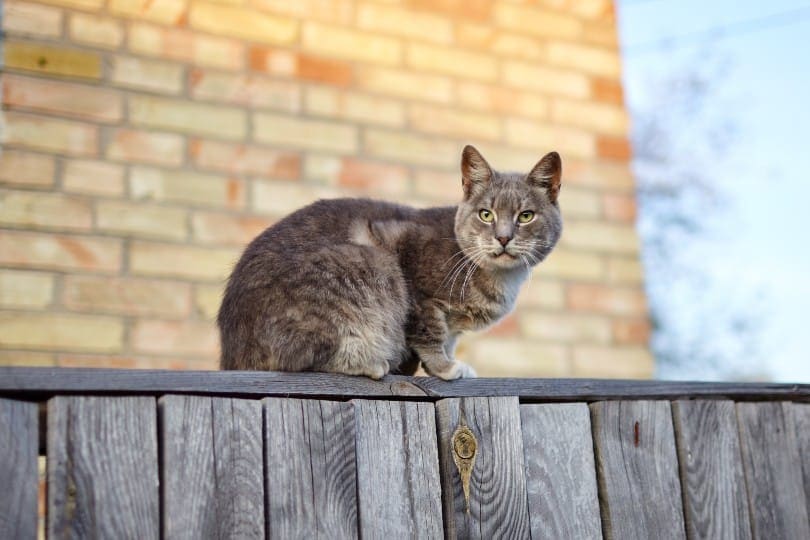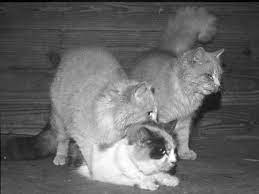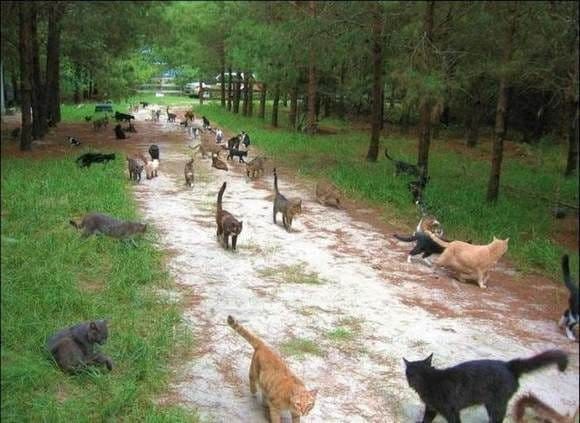Members of the Felidae, or cat family, are lone predators and do not live in socially organised groups with the exception of lions.
Wildcats, the forerunners of domestic cats, are solitary animals, but domestic cats exhibit a more diverse range of social behavior.
Which is mostly influenced by population density and the availability of food sources. The cat, Felis catus, has proven to be a very adaptable creature. While retaining its roots as a lone hunter, it will develop social structures to adapt to group-living under various circumstances (both natural and artificial). Typically, the living arrangements of free-ranging domestic cats can be divided into two categories: those in which females maintain solitary status with individual territories, and those in which females form compact groupings that resemble a pride of lions (more typical of most wild felids).

Geographical importance
Because cats are a species whose individuals are essentially solitary hunters, it is vital for them to create a territory (i.e. hunting territory) and that this be defined in a way to generally prevent conflict with other cats (for the survival of the species). Cats thus mark their territory with odors from anal glands, urine, feces, and facial glands. With the help of territorial marking and their exceptionally keen sense of smell, cats are able to communicate effectively and minimize direct confrontation among themselves.
A cat’s territory is organized around a central area called a den, where it feels secure enough to sleep, eat, play, and possibly socialize with other cats. This acts as the geographic center of the territory, which extends beyond the core area and is fiercely guarded by the cat. Usually located beyond here is the cat’s home or hunting range, which comprises the majority of its travel range.
Territories in the wild may overlap with “neutral zones” where cats can interact and socialize. When an unfamiliar cat enters another cat’s territory, the other cat typically responds by engaging in an aggressive engagement to drive the unusual cat away, first with staring, hissing, and growling, and if that is unsuccessful, through a swift, violent attack.

Colonial way of life
Based on the location of food sources, feral cats, or cats living in the wild, can and do form small colonies. While some species prefer to live alone, it is possible for small, cooperative groups of females and kittens to form (matrilinear colonies). These groupings may have a relatively loose dominance structure, but the relationships are complex and do not create an integrated hierarchy, as they would, for example, in canine social groups. As a result of their degree of relatedness, as well as their age, sex, and other circumstances, some cats may have greater affiliative links than others, making relationships complicated. But they continue to be lone hunters rather than developing a pack mindset or a group survival strategy. Cats are not ‘pack’ animals since they have the ability to adapt and form social groups.
Where cat social groupings do exist, they only appear to work well when the group members are acquainted with one another and when there is little rivalry for food or other resources. Particularly between kittens from the same litter and between kittens and their mothers, cats can form strong ties with individuals they know. However, in feral cat colonies, many lactating queens may often nurse (suckle) kittens, and this may help them develop social skills at a young age. In fact, kittens may try to nurse from non-lactating queens, which could promote the growth of social ties.
The main food source may be connected to a larger “central” colony of females, while smaller “peripheral” groups may form around the core colony. These peripheral groups would still have access to the food source but would have less favorable conditions for access, health, and reproduction.
Male cats
Because they are rarely seen in small colonies, male cats typically reside on the periphery with large territories that may overlap multiple groups of females. Although female territories can vary widely in size, the quantity of food and the number/density of females in the group are probably the main factors. Female colonies and groupings often have more defined and condensed territories. Studies suggest that the size of “home ranges” may vary by a factor of a thousand depending on the location (eg, 0.27ha for a city-living feral cat in Jerusalem to 170ha for a cat in the Australian bush). The size of the male territories can be connected to food availability and female population density. Male territories may or may not overlap, although normally there is significant overlap (more so than between female groups). Male territories are typically 10 times larger than those of female groups, with powerful men having potentially larger domains (on average three times larger). It seems to prefer larger male territories when there are several small groups of females that are not too widely dispersed.
Aggression
Aggression is rare in the feminine colonies, therefore strong female affinity and familiarity help to keep it at bay. Most often, conflict occurs between males and females when male kittens reach sexual maturity and are evicted from the group or when a tom “patrols” his territory. Women are typically antagonistic to males who approach too closely if they are not sexually receptive, but toms rarely show aggression toward women. But there will also be pleasant activity, such as allogrooming and “greeting” behavior (tail up, sniff noses, rub heads), between females and toms, especially when there is a lot of familiarity. Males who have reached adulthood interact differently, and this is frequently characterized by hostile conduct, avoidance, or tolerance rather than pleasant behavior.

The kitten or cat of your choice has been selected. What needs to be prepared? How can you make sure you’ll make a good owner?
The best way to ensure your cat’s wellbeing is to understand the demands of the species and use that knowledge to build a suitable habitat. Even though some of the crucial elements are rather simple, owners usually ignore them.
Sometimes it can be easy to confuse what cats might desire with what we might want. However, cats are not persons. As you begin to think like a cat, other things will begin to make more sense, and you’ll begin to see your cat and its actions in a whole different perspective. Knowing what your new cat or kitten needs will make it easier for you to welcome it.
One thing we as owners must realize is that the majority of cats respect their habitat much more than the people that reside there.
It is important for a cat’s owner to understand how its environment affects it and provide security for it; this will always deepen the link between cats and people.
A safe space
Despite the fact that we often consider cats to be “domesticated,” we are actually merely toying with a species that evolved from a lonely animal over millions of years. No matter how big or small you are, as a cat, your natural impulse is to clear an area of the terrain that will have enough wildlife to feed both you and, if you are female, your kittens. This is accurate unless you’re a lion or a member of a related species still being raised by your mother. You don’t want another cat to plunder your pantry once you’ve finished doing this. You’re obviously very protective of your territory because it’s a matter of life or death. A wild cat, also referred to as a feral cat (a domestic cat that lives in the wild without human intervention), will have a large area to roam, a smaller area that it will tenaciously defend, and a little den where it feels safe. A female cat gives birth to her kittens in the den. Despite being spayed or neutered pets or feral cats, our cats are nonetheless impacted by this drive (most pet cats could also survive in the wild if they had to).
Think about the safe sanctuary our cats have in the place we call home. Both of us and they could sense their safety inside. Although the cat’s litter box is in a conservatory, we might be unaware that another cat is “visiting” through the cat flap or an open window, or that it is upsetting the peace by gazing through the glass windows. Perhaps the nearby cat is standing guard outside the cat flap, ready to pounce on your cat as it emerges. These elements could all contribute to your indoor cat feeling rather scared and anxious.
Knowing the significance of these elements allows you to take preventative measures, such as positioning the litter box in a safe area and keeping other cats out, to ensure your cat feels secure. If you offer the cat a way in and out of the house using a cat door or catflap, giving it a “key” on its collar using a magnet, a microchip, or an electrical device so that it can open its own cat flap but other cats can’t get in would ensure security. When they don’t have a cat door, some people just let the cat in and out as needed.
What facilities would my cat or kitten require?
We are all aware that a cat needs food, drink, and a litter box if it stays inside or stays away from the outside. But it’s a little bit more complicated than that. The cat’s food, drink, and litter box are typically arranged in a line so that they are simple for the cat to locate and use. What about that is wrong? If given the choice, a cat will undoubtedly choose to drink away from its consumption area and will undoubtedly eat and drink away from its bathroom. It is necessary to comprehend the necessity of splitting these vital resources in order to comprehend a cat.
The following things are required:
- A pan, tray, or urinal
What to look for when choosing a cat’s litter box, litter, and littering area.
- A cozy bed
The placement of a bed can either encourage or dissuade a cat from using it, regardless of its design, size, or substance. Because they can see what is below them and are not concerned with what is above them, cats prefer to be higher up. Although there are many choices, your own bed will likely be your first choice.
- Private places
Cats need high places in homes where they can retreat, retire, take a nap in safety and privacy, or flee from a visitor or household activity (person or dog). For more stressed cats, having a space to relax can be a blessing. Additionally, cats love to hide in warm, comfortable beds, especially when they are feeling a little uneasy. Cats must be able to conceal themselves in secluded spaces so they can run from any potential dangers. When a cat decides to hide, their owners must accept that decision and not bother them.
- Litter box
If you’re acquiring a kitten, a pen for them can literally save their lives. One is available to buy, rent, or borrow. Use a dog cage that people store in their car trunks or one of the particularly designed kitten or puppy enclosures, which are roughly 1 m x 0.75 m x 0.75 m in size.
- Transporting package
Essential for bringing your new cat home, as well as for visits to the vet or cattery. If you haven’t lived with a kitten for a while, you might forget how they get into everything and how their curiosity sometimes puts them in danger. If you can secure them in the pen while you leave the house or at night, you may be sure they won’t cause trouble for themselves. Regardless of whether you have dogs, other cats, or young children, the pen gives kittens some time alone because they really need a lot of sleep. They pick up cuddling up quickly because they feel safe doing it on their end. Additionally, it is a fantastic way to introduce kittens to dogs, cats, and children so that the animals can get acclimated to it and the kitten is safe. For a bed, a litter box, food, and water, there is room within. There are many different designs, but the most important thing is to choose one that the cat can enter and depart safely.
Selecting and utilizing a cat basket for traveling
- Toys
Cats love to play, and anything from a piece of paper to a designated cat play area might be the starting point. It’s a great way to engage with your cat and encourage it to express its energy and instincts. However, problems could occur if cat owners mistreat their animals.
Playing cat and mouse
- Identity has importance
Especially if your cat likes to go outside. According to International Cat Care, all cats should be microchipped, but you might also wish your cat to wear a collar for obvious identification or to have a “key” to the cat flap.
- Identifying your cat
How to choose and tinker with a cat collar
- “Cat flap”
The creation of the cat flap has completely changed the way people care for their feline friends because it allows the cat to have unrestricted access to the outside without leaving a door or window open, keeping the house secure and eliminating the need for the cat to wait outside before being let inside. Simple flaps that can frequently also be locked in or out, flaps that are locked until released by a magnet or an electronic key on the cat’s collar, and cat flaps that are triggered by the cat’s microchip are just a few of the several sorts of flaps that are already widely accessible (or can be programmed for several microchips should you have several cats). In areas with a high cat population, International Cat Care advises choosing a cat flap or door that can prevent stray cats from entering the residence.
How to select and use a cat flap for your cat
- Scratched post
To mark its territory, a cat will naturally sharpen its claws and scratch. While most cats prefer to do this outside, some may also choose to do it indoors. The cat won’t scratch the furniture because it will have a place to do it on a scratch post.
- Safeguarding your pet
If you have never had a kitten in the house, it would be a good idea to conduct a quick evaluation to find any potential danger locations (or if it has been a while). A lot of things can poison cats, some things can burn their paws or skin, and certain things should be avoided. It is advised to remove hazardous plants and chemicals and to look around to make sure that there aren’t any small objects, such as needles and thread, lying around.
- Hazards to kittens and cats in the home
- Cats and poisons
- Cats and poisonous plants
Now you’re ready to meet your new kitten or cat! Bring your cat carrier rather than leaving your brand-new kitten unattended in the car.
RELATED: Preparing for your new Cat or Kitten

